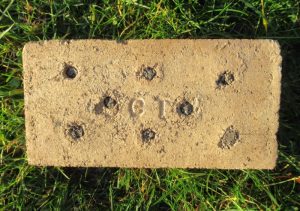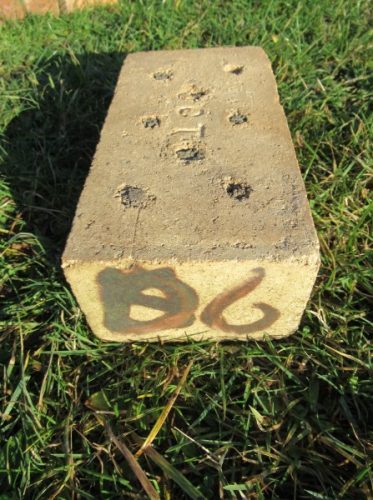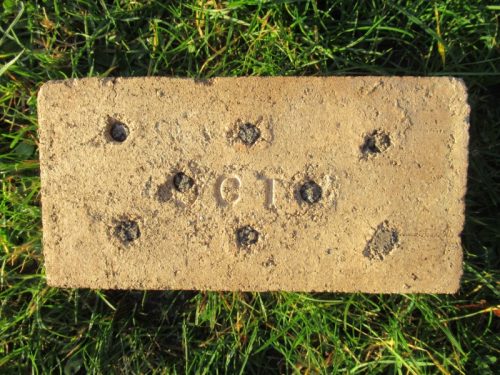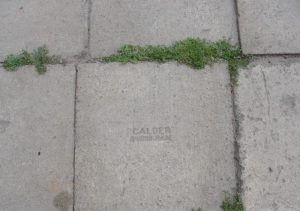
Found by Ian Suddaby at High Bonnybridge.
This example is not in my possession.
Ian states – OCTO is a high alumina specialist firebrick brand made by the Bonnybridge Silica & Fire Clay Co. Ltd. at Bonnybridge near Falkirk, Central Scotland.
This example is a standard brick size, 3″ x 9″ x 4½” but for some reason, eight metal rods have been driven through it prior to firing. One of these has caused the fireclay to split and perhaps for that reason, the brick wasn’t used. It looks as if these rods have then been broken off after firing has taken place. None of the sixteen exposed rod ends have been cut. The end of the brick has been painted with what is probably B6.
I don’t know what the metal rods are made from but they might be cast iron. Surely not many metals will snap off easily like that, without cutting or repeated bending and there is no visible rust on the ends, despite being outside for at least 40 years. As cast iron has a melting point above that normally used to fire bricks, they could have been fired with the rods in place.
I have no idea why this was produced and have never found anything similar. Quite intriguing really.
Below – Bonnybridge Silica & Fireclay Co Ltd, Bonnybridge.
alt
Calder Firebrick Works, Airdrie, Lanarkshire.
alt
Chapelhall Works, Lanarkshire.
Hepworth Ceramic Holdings plc (GR-Stein Refractories Ltd. parent co) bought the Bonnybridge Silica & Fireclay Co. Ltd in 1972, closed Bonnybridge works in 1973 and closed Chapelhall in 1980. Therefore between 1972 and 1980, GR-Stein Refractories probably continued to manufacture bricks with this trademark for a time.
.
.
Below – An interesting facebook conversation on the subject.
-
William Pirt – Looks like a lab test brick that has been prepared for a thermal conductivity test. Just a thought…!!
-
William Pirt – Is the black staining around the rods sooty? Another possibility is that the brick has been prepared for a carbon monoxide resistance test.
Ian Suddaby – No, not sooty. The brick was outside in a dumping area for maybe 40 years. Not rusty either which made be think cast iron. Good idea re thermal conductivity thanks.
Ian Suddaby – You’d need to explain the carbon monoxide resistance test I’m afraid.
William Pirt – In CO resistance test the brick is subjected to carbon monoxide gas at a temperature of around 500 deg C and if the brick is permeable and contains iron spots the gas breaks down and precipitates carbon black around the iron spot and causes unstoppable cracking as the carbon deposits push the brick apart, crumbling it. The test is particularly important for chimney and flue bricks and for blast furnace and certain retort bricks at temperatures up to around 800C. Above this temperature, carbon will not form as C but stays as CO. Test method for CO resistance is BS EN ISO 12676:2003. If there is no sooting around the iron inserts then it is unlikely to have been subjected to this test. The marking B6 on the end of the brick suggests strongly it has been a laboratory or trial panel brick which may have been marked with green chromic oxide paint, which turns dark brown/black on heating. if the Octo has been hard fired it will be most likely CO resistant, as hard firing reduces the brick’s permeability to gases.
Ian Suddaby – How interesting William. Thanks very much for that. The B6 is indeed a dark brown colour and the lab brick idea makes sense. I’ve been collecting bricks for a long time and have never found one like this. Mark Cranston will be interested too.
Mark Cranston – Yes all sounds very interesting and why not! All the big fire brickworks had labs so no reason why we won’t come across lab test throwaways from time to time.
William Pirt – Is it confirmed that the inserts are ferrous? This can perhaps be confirmed with a magnet. Is there any off-chance that the inserts could be aluminium?
Ian Suddaby – I don’t have a magnet handy William. There is no rust at all and the broken ends have that slightly granular look that broken cast iron has. So nothing definite.
Ian Suddaby – I just found a magnet for a cat collar that picks up nails etc no bother. There is no hint of attraction to those rods so they could be aluminium.
William Pirt – It is the very slight blackening around the metal that intrigues me when examining the metal inserts close up. If this is not carbon and the metal is aluminium or an aluminium alloy (or a set of various composition al-alloy rods), then this brick COULD be from an aluminium corrosion resistance test, which would be carried out at 850C for 96hrs (ALCAN test). The idea is that if the alloy reacts with the brick during this time then the brick has failed the test. An indication of failure would be extensive blackening of the brick around the site of the rods, due to the reaction of the metal with the brick components. If the rods are aluminium alloys it is most likely this is a lab test brick from that test. Just another thought….!!
Ian Suddaby – Great information once again William. I’ll get a steel blade and scratch the surface of one of those rods. That must distinguish aluminium (or other metal) from carbon,
William Pirt – Firebricks are common components of aluminium melting and holding furnaces, launders and runners, and when fired hard are quite resistant to molten aluminium, but if furnaces are run too hot, or if the bricks are not hard-fired, they will react with the metal quite badly.
Ian Suddaby – I did that and no hard shiny surface appears. Under bright light the broken ends glint a bit but are a grey-black. A couple of fragments flaked off and are gritty in the fingers, nothing like graphite, more like a fine-grained volcanic rock. The brick isn’t visibly discoloured at the interface.
William Pirt – Its not just a mortar is it?
Ian Suddaby – No, it’s not like any firebrick cement I’ve seen. Normally, cements closely follow the composition of the brick so they react in a similar way as I’m sure you know. It might be some sort of carbon rod, it’s certainly looking like it’s not metal. Definitely something that can be pushed through the ‘wet’ brick and broken off without distorting the brick. That’s why I thought it was broken off after firing.
William Pirt – These are dry pressed products so it’s unlikely anything could be pushed through it when green. The brick could however have been drilled after firing then something put into the holes. If carbon rod then this would be jet black and would burn out when heated, so have no answer!!
Ian Suddaby – Yes, dry pressed, these will be the 1930s or after probably. Brick collecting is full of mysteries. These rods are a very tight fit, certainly not just pushed into pre-drilled holes though some sort of bonding material might do it. You can see where one of them looks like it’s split the brick when pushed through. I don’t know but thanks for the help William. Very useful.













